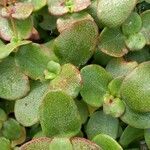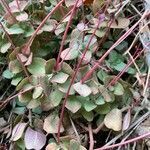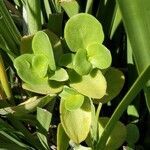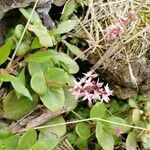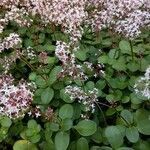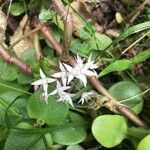Perennials with decumbent to almost erect branches rarely longer than 0.4 m, sparsely branched, with old leaves not deciduous. Leaves with petioles 5-20 mm long; lamina broadly elliptic to oblong-obovate, 20-50(-65) x 15-40 mm, obtuse or emarginate, more or less abruptly constricted into petiole, dorsiventrally flattened, with slightly recurved margin, entire, green often yellowish green. Inflorescence a rounded or elongate thyrse with few to many dichasia, with 4-or 5-merous flowers, with peduncle 30-80(-100) mm long. Calyx: lobes triangular, 1-2 mm long, acute and ridged, glabrous, green sometimes tinged red. Corolla star-shaped, fused at base for about 0.5 mm, cream or white and usually tinged red towards apices. Stamens with purple anthers. Squamae transversely oblong, 0.2-0.3 x 0.4-0.6 mm, truncate, not constricted downwards, fleshy, white or cream.
Perennial succulent, soft, decumbent, 0.4 m long, sparsely branched, old leaves not deciduous, no adventitious roots at nodes. Leaves broadly elliptic to oblong-obovate, 2050 x 15-40 mm, obtuse or emarginate, abruptly constricted into petiole, entire, green to yellowish green, recurved margins; petioles 5-20 mm long. Inflorescence a rounded to elongated thyrse, several dichasia, vegetative adventitious buds on old inflorescence; peduncles 30-80 mm long. Calyx fleshy, glabrous, ridged, green tinged red. Corolla star-shaped, fused at base, cream-coloured tinged red towards apex; lobes 3-4 mm long, sharply pointed, slightly hooded and slightly ridged, spreading at right angles, closing after flowering. Flowering time May-Aug.
Plants terrestrial, perennial. Stems erect or decumbent, reddish green in age, branched, 20-40 cm. Leaf blades obovate to broadly elliptic, 20-50 mm, apex obtuse or emarginate. Inflorescences lax, flowers 2 per node. Pedicels 3-8 mm. Flowers 4-merous; sepals broadly trian-gular, 1-2 mm, apex acute; petals narrowly triangular, 3-4 mm. Follicles erect, 12-20-seeded, obliquely lanceoloid; old follicles not seen. Seeds ellipsoid, 0.3-0.4 mm, rarely formed, other characters not known.

